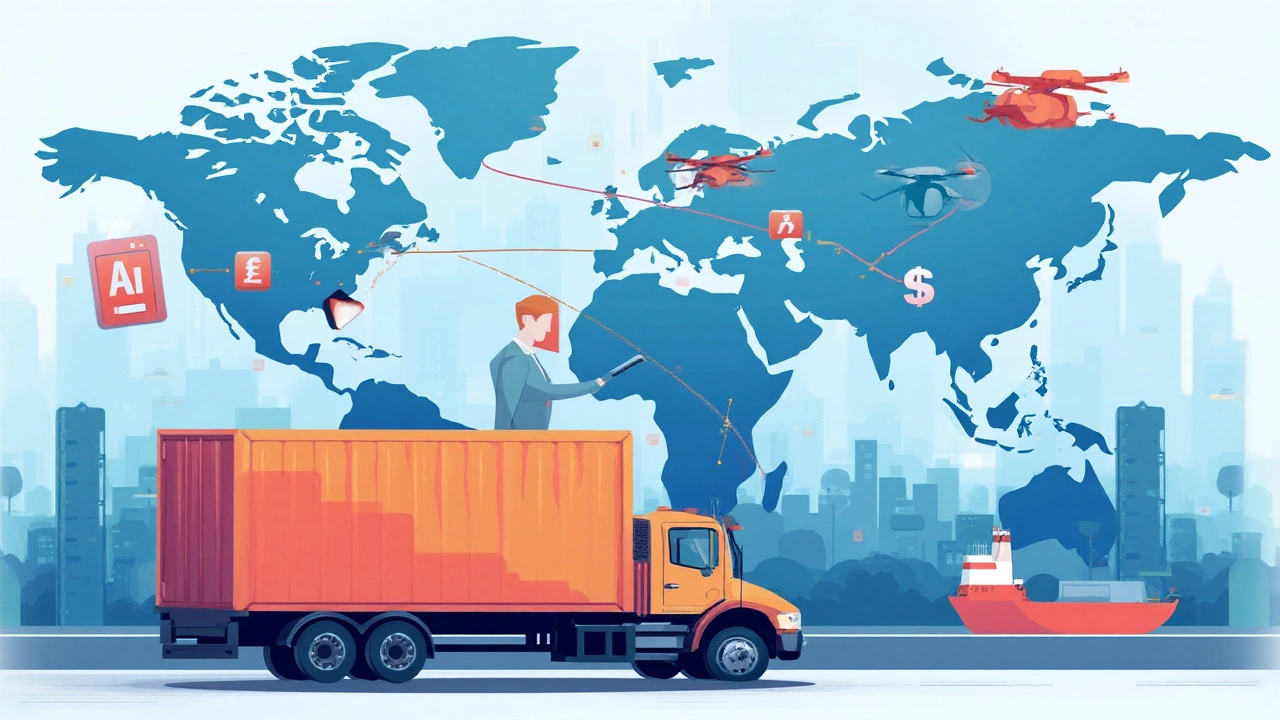Sending a simple package across borders sometimes feels like launching a satellite—complicated, full of surprise fees, and painfully expensive. Ever looked at a shipping quote and wondered if it was a mistake? You’re not alone. International shipping in 2025 is still pricey. Carriers add fuel surcharges, customs brokers slip in their fees, and packaging mistakes can double the final bill. There’s real money to be saved if you know where to look and what to avoid. Let's pull back the curtain and lay out how you can actually pay less the next time you need to send something overseas—without sacrificing reliability or pulling your hair out in frustration.
Understanding Shipping Costs: Why Are They So High?
International shipping fees are the stuff of nightmares for small businesses and eBay regulars. Why is it so expensive? It’s not just profit chasing from big carriers. Start with the obvious: distance and fuel. Longer trips burn more fuel, which isn’t getting any cheaper, especially if your route hits regions like the Middle East, where surcharges spike quickly. Tariffs and customs duties? Those transform a $20 fee into $80 in a blink as governments add VAT, import fees, and random processing costs.
Then there’s the size and weight game. Carriers now use dimensional weight—that dreaded formula where size matters more than actual heft. Ever shipped a fluffy plush toy and been floored by the cost? That’s dimensional pricing at play. Here’s a wild stat for you: according to the International Air Transport Association, over 65% of international air freight bills in 2024 were based on dimensional weight, not actual scales.
Packaging itself eats money. Oversized or poorly packed items might cost double because carriers charge for wasted space. Cheap packaging can also mean more breakage, which leads to insurance claims and, of course, even more fees. And don’t forget the hidden toll: customs documentation. Missing or incorrect paperwork can get a shipment stuck, leading to storage fees that pile up fast. In 2023, US Customs reported nearly $430 million collected just from administrative delays. Every form has to be filled properly, and if not, your goods could be delayed for days—or even weeks—incurring extra warehousing costs.
Transport routes also complicate the math. If your package travels through multiple countries, it might switch carriers. Every handoff adds a layer of cost, and sometimes, carriers with slick advertising actually subcontract to smaller partners, which means extra margins at every hop. Add seasonal surcharges—think Christmas or Chinese New Year—and your shipping price can triple without warning.
Let’s not gloss over insurance. For high-value items, you’ll want it. But carriers often charge a percentage of the declared value, which on bigger shipments can really add up. Lastly, there’s the wild card: currency exchange. Even a small fluctuation can mean you pay more if a carrier processes payment in euros or yen.
Here’s a fun table that breaks down the average international shipping cost contributors for 2024, based on World Bank and major carrier data:
| Cost Component | Average Percentage (International Shipment) |
|---|---|
| Base Carrier Fee | 42% |
| Fuel Surcharge | 17% |
| Customs/Duties/Taxes | 18% |
| Documentation/Handling | 8% |
| Packaging | 5% |
| Insurance | 3% |
| Currency/Other | 7% |
The bottom line? Multiple hands dip into your wallet at every step. Still—each of these pain points can be trimmed with the right knowledge.

Killer Strategies to Cut Shipping Expenses
Now that you know where your money goes, what can you actually do about it? There’s no magic button, but plenty of real-world tactics make a measurable difference. Want to start with something immediate? Always compare carriers, but don’t stop there. Online shipping marketplaces—like Sendcloud, ShipStation, or Easyship—pool bulk shipping rates you can’t get on your own. Some users have saved up to 60% on routine international parcels just by joining these platforms.
Re-think your packaging. This one’s huge. Order the smallest possible boxes, use compressible fill, and measure every dimension. If you’re shipping similar items on a regular basis, invest in a box-sizer. Shrink your package by even an inch, and you could save dozens of dollars per item on long-haul routes. Use digital kitchen scales to check your package’s actual weight at home before getting quotes. If your box is under certain weight or size thresholds, you might qualify for steep discounts with services like USPS First Class International or Royal Mail International Standard.
The most powerful hack? Consolidate shipments whenever possible. Bundle multiple orders to the same destination into one larger box, then use local courier services or a freight forwarder to split up packages on arrival. This works wonders for sending care packages to relatives or running an online store with multiple customers in the same country.
Smart timing also pays off. Avoid peak seasons—May and December are usually the worst for surcharges. If you can wait a week or two to ship, track historical carrier pricing using tools like ParcelSpy or AfterShip. These can show you when rates dip, letting you choose the cheapest window.
Let’s get specific with some actionable tips you can start using right now:
- Negotiate with carriers if you send at least 5 international parcels a month—most carriers offer custom rates to frequent shippers, and some don't advertise these plans at all.
- Use flat-rate shipping whenever possible. UPS, FedEx, DHL, and postal services offer flat-fee boxes that often beat calculated rates, especially on heavier but compact items.
- Automate label creation. Many platforms slap on small admin fees for manual processing. Creating digital labels yourself saves a few bucks every single time.
- Always double-check customs documentation using the latest country codes. Incomplete forms are the number-one cause of delays, and time equals money if you’re renting warehouse space or paying storage fees abroad.
- If shipping to developing countries, investigate last-mile partners. National postal services are sometimes far cheaper, even if delivery speed drops by a day or two.
- Apply for international shipping discounts from e-commerce platforms. Shopify, WooCommerce, and others often have exclusive carrier partnerships for members.
- Cross-border returns? Use local return centers or third-party logistics providers in the destination country to dodge huge return shipping expenses.
Don’t ignore bulk shipping supplies. Buy boxes, tape, and padding in wholesale packs from supply stores instead of the post office. A 2024 survey from ShipBob put the average savings at nearly 30% per item just from this switch. And if you’re running a business, consider integrating with logistics software—these tools can spot rate changes fast and automate the boring stuff for you.
Here’s the wildest tip most miss: check country-specific prohibitions and size restrictions before shipping. Ship something that’s banned (even by mistake), and not only does it get destroyed or returned at your cost, but you’ll still be billed every step of the way. That’s a one-way ticket to losing money you’ll never get back.
Finally—always compare quotes using incognito mode or after clearing cookies. Carriers and broker sites sometimes adjust displayed prices based on browsing history, similar to travel booking sites. Fresh browsers can mean fresher, lower quotes.

Leveraging Technology and Partnerships for Bigger Savings
We’re deep into 2025 now, and the best savings come from mixing technology with smart business moves. Top shipping aggregators now offer predictive pricing. If you input your destination, weight, and timeline, these tools use AI to scan thousands of routes and spit out the cheapest option. Some companies report up to 40% lower costs using automated AI brokers rather than sticking with a single carrier. These platforms—like Freightos, Flexport, and MyCarrier—are no longer reserved for huge corporations, and even small sellers can sign up.
Integrate your e-commerce shopping cart with logistics software. This doesn’t just automate tracking and label creation; it also instantly flags when your package hits a carrier rate threshold or when a service promotion can save you money. Shopify, BigCommerce, and Wix platforms all offer discounted international shipping labels in 2025—sometimes as a hidden perk. Make sure to check your account dashboards for new partnership deals.
Modern tracking systems now show not just where your package is, but what costs you’re racking up at each step. You can spot a bottleneck in customs before it spirals into a warehouse storage fee. Investing in these tools is like having a shipping concierge in your pocket, especially for time-sensitive or high-value items.
Automation saves a ton of time and money. Bulk upload your shipment data, schedule pickups automatically, and let the system flag the best time and carrier. These platforms even warn you when new country tariffs make a destination temporarily expensive. Proactive shippers on these systems report cutting nearly a full day off international lead times and knocking down costs by a fifth, just by dodging the wrong weeks and carriers.
Let’s talk about strategic partnerships. If you run a small e-business or hobby shop, join a trade association or local business group. In 2024, over half of small UK eBay sellers slashed shipping costs by joining collective logistics programs, where you pool shipments for volume discounts and get access to better rates negotiated by the group. Even individuals can benefit: international shipping forums (think Reddit’s r/shipping or specialized Facebook groups) often share fresh discount codes, carrier deals, and even split bulk rates among multiple members shipping to the same region.
Another route: 3PLs (third-party logistics). If you routinely send packages to one region (say, Southeast Asia or Europe), partner with a fulfillment center there. You ship in bulk to the center, then they handle the local last-mile delivery—usually at a fraction of the cost and with custom-tailored packaging that sidesteps size-based fees. A Beijing-based fulfillment warehouse quoted 2025 international last-mile delivery costs as 35% cheaper for sellers using this system versus standard a-la-carte carrier bookings.
Here’s a handy breakdown of what different technology solutions save on average, based on real 2024 user data:
| Technology or Partnership | Estimated Savings (%) |
|---|---|
| Shipping Aggregator (AI-Based) | 40% |
| E-commerce Platform Shipping Discounts | 15% |
| Bulk Supply Ordering | 30% |
| Shipping Cohorts/Groups | 25% |
| Third-Party Logistics Centers | 35% |
It’s worth pointing out that not every shipping hack works for every shipper. High-value, low-weight goods benefit from specialized insurance, while bulk low-cost items might score biggest by bypassing air carrier “express” options in favor of consolidated freight.
Don’t underestimate the power of feedback, either. After each shipment, ask your recipient how the package arrived. If it’s overpacked, got stuck in customs, or arrived late, tweak your next strategy. Use email or quick online surveys—all of which help you catch problems in your system early, saving more long term. And yes, anecdotal reports from dozens of businesses show that you really do save money when you keep your recipients in the loop—they notice delays, missed deliveries, and damaged packages faster than tracking systems do.
International shipping doesn’t have to empty your wallet. Armed with the right mix of smart packaging, comparison shopping, and clever tech, you can pull your costs back down to earth. The best time to start saving money? Before the next package even leaves your house. Now that you’ve got the facts, take action—and watch those shipping bills shrink for good.





